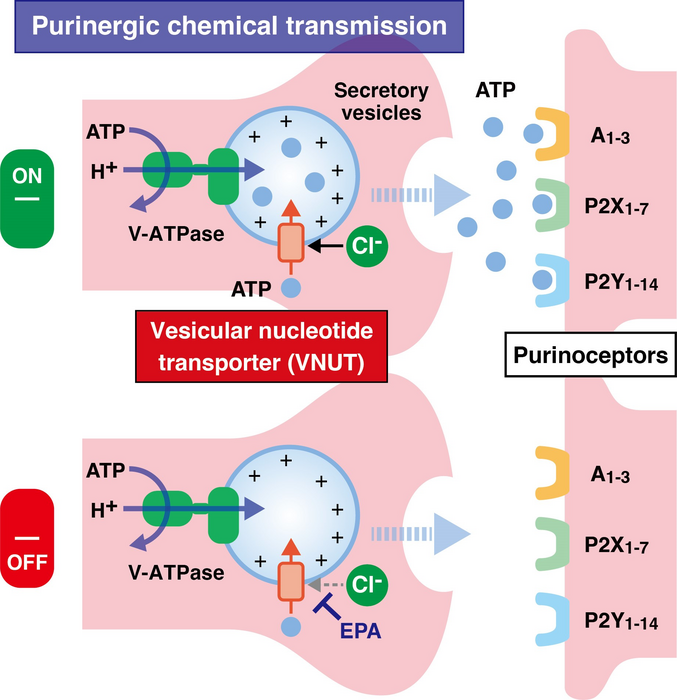Eicosapentaenoic acid (EPA) is an essential nutrient belonging to the omega-3 group of polyunsaturated fatty acids (PUFAs). As the human body cannot synthesize PUFAs, dietary supplements containing EPA are required for normal physiological functions. Found abundantly in natural sources like fish, hemp oil, and linseed oil, EPA is known to exhibit anti-inflammatory, neuroprotective, and cardiovascular protective activities. Additionally, recent studies have demonstrated its therapeutic effects in reducing mortality risk after myocardial infarction, improving insulin resistance, reducing blood lipid levels, and inhibiting platelet aggregation. Omega-3 PUFAs have also been shown to decrease inflammatory responses following COVID-19 infection. Despite the wide spectrum of its therapeutic effects, the molecular target(s) and the underlying mechanism of EPA’s action remain elusive.

Credit: Takaaki Miyaji from Okayama University
Eicosapentaenoic acid (EPA) is an essential nutrient belonging to the omega-3 group of polyunsaturated fatty acids (PUFAs). As the human body cannot synthesize PUFAs, dietary supplements containing EPA are required for normal physiological functions. Found abundantly in natural sources like fish, hemp oil, and linseed oil, EPA is known to exhibit anti-inflammatory, neuroprotective, and cardiovascular protective activities. Additionally, recent studies have demonstrated its therapeutic effects in reducing mortality risk after myocardial infarction, improving insulin resistance, reducing blood lipid levels, and inhibiting platelet aggregation. Omega-3 PUFAs have also been shown to decrease inflammatory responses following COVID-19 infection. Despite the wide spectrum of its therapeutic effects, the molecular target(s) and the underlying mechanism of EPA’s action remain elusive.
Research Professor Takaaki Miyaji from Okayama University, Japan, and his team of researchers have now uncovered a novel molecular target of EPA in their recent work published in the journal Proceedings of the National Academy of Sciences of the United States of America (PNAS) on July 18, 2022. Explaining the rationale behind their study, Research Professor Miyaji, the corresponding author of this paper, says, “Conventional molecular targets such as COX-2 inhibitors can explain the anti-inflammatory and analgesic effects for inflammatory pain, but not neuropathic pain, of EPA. However, since EPA significantly attenuates both inflammatory and neuropathic pain, there is a strong possibility that there exists another important molecular target of EPA related to neuropathy.” Diving deeper, the team, thus, sought to understand the mechanism of action of EPA in alleviating both inflammatory and neuropathic pain.
During neurological, metabolic, and immunological disruptions, “purinergic” chemical transmission (a form of extracellular signaling mediated by purine derivatives), leads to the binding of energy carriers like adenosine triphosphate (ATP) to “purinoreceptors,” which induces and exacerbates neuropathic and inflammatory pain perception. This binding is mediated by a vesicular nucleotide transporter (VNUT), which thus becomes the key molecule in the initiation of purinergic signaling. The researchers hypothesized that EPA targets VNUT, thereby blocking purinergic chemical transmission and reducing pain perception.
Research Professor Miyaji and his team tested this hypothesis both in-vitro, using human derived VNUT, and in-vivo, using a VNUT-deficient mouse model.
They found that EPA competes with chlorine ions that normally activate VNUT and inhibits VNUT-mediated release of ATP. Moreover, they observed this effect with EPA and its metabolites only, and not with docosahexaenoic acid, another omega-3 fatty acid, thus, suggesting that the structure of omega-3 fatty acids with side chains is necessary for VNUT inhibition.
Further, they induced neuropathic pain in wild-type and VNUT-deficient mice using chemotherapeutic agents that are used in cancer treatment. Notably, EPA accentuated pain in wild-type animals, but not in VNUT-deficient mice, thus corroborating their earlier finding on the inhibitory effect of EPA on VNUT. Similarly, insulin resistance induced by neuropathic pain has been shown to be reduced by EPA treatment in wild-type, but not in VNUT-deficient mice.
“We found that low concentrations of EPA completely and reversibly inhibited the release of ATP from neurons, without inhibiting the release of other neurotransmitters. Compared with other drugs, EPA demonstrated a higher analgesic effect and fewer side effects,” explains Research Professor Miyaji.
Besides, neuropathic pain and associated insulin resistance, the analgesic effects of EPA can be further extended to chronic pain associated with several other conditions like chemotherapy, diabetes, rheumatism, gout, sciatic nerve ligation, and inflammation. Additionally, purinergic chemical transmission is also associated with a variety of conditions including Alzheimer’s disease and depression, for which EPA can be explored as a therapeutic strategy.
Moreover, opioids and other pain-relief medications can have long-term side effects and result in addictions. In the absence of optimal drug treatments with fewer side effects, chronic pain leads to a decreased quality of life, besides increasing the economic burden of treatment. With this discovery, ‘nutrient-based EPA’ and its metabolites can be indicated in the management of chronic pain, while also keeping potential side effects at bay.
Elaborating the long-term implications of their research, Research Professor Miyaji adds, “Our results can help develop novel nutrient-based treatment and prevention strategies by targeting purinergic chemical transmission for inflammatory, neurological, and metabolic diseases, without the adverse side-effects of conventional pain-relieving medications.”
Who wouldn’t be excited at the prospect of having safer and natural pain relief strategies? We certainly are!
About Okayama University, Japan
As one of the leading universities in Japan, Okayama University aims to create and establish a new paradigm for the sustainable development of the world. Okayama University offers a wide range of academic fields, which become the basis of the integrated graduate schools. This not only allows us to conduct the most advanced and up-to-date research, but also provides an enriching educational experience.
Website: https://www.okayama-u.ac.jp/index_e.html
About Research Professor Takaaki Miyaji from Okayama University, Japan
Takaaki Miyaji is a research professor affiliated with the Advanced Science Research Center at the Okayama University, Japan. He completed his doctoral studies from Okayama University in 2009 before embarking on his professional journey. His research spans across life sciences, such as pharmaceuticals, nutrition, health sciences, and pharmacology. Research Professor Miyaji along with his peers, was the first in the world to identify a Vitamin C transporter in plants. He is also the recipient of the 2018 Young Scientists’ Prize of Commendation for Science and Technology. He wishes to contribute to the domain of life sciences with his research expertise.
Journal
Proceedings of the National Academy of Sciences
DOI
10.1073/pnas.2122158119
Method of Research
Experimental study
Subject of Research
Animals
Article Title
Vesicular nucleotide transporter is a molecular target of eicosapentaenoic acid for neuropathic and inflammatory pain treatment
Article Publication Date
18-Jul-2022
COI Statement
The authors declare no competing interest.




